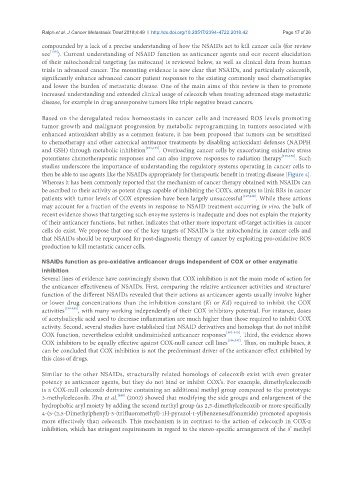Page 597 - Read Online
P. 597
Ralph et al. J Cancer Metastasis Treat 2018;4:49 I http://dx.doi.org/10.20517/2394-4722.2018.42 Page 17 of 26
compounded by a lack of a precise understanding of how the NSAIDs act to kill cancer cells (for review
see [133] ). Current understanding of NSAID function as anticancer agents and our recent elucidation
of their mitochondrial targeting (as mitocans) is reviewed below, as well as clinical data from human
trials in advanced cancer. The mounting evidence is now clear that NSAIDs, and particularly celecoxib,
significantly enhance advanced cancer patient responses to the existing commonly used chemotherapies
and lower the burden of metastatic disease. One of the main aims of this review is then to promote
increased understanding and extended clinical usage of celecoxib when treating advanced stage metastatic
disease, for example in drug unresponsive tumors like triple negative breast cancers.
Based on the deregulated redox homeostasis in cancer cells and increased ROS levels promoting
tumor growth and malignant progression by metabolic reprogramming in tumors associated with
enhanced antioxidant ability as a common feature, it has been proposed that tumors can be sensitized
to chemotherapy and other canonical antitumor treatments by disabling antioxidant defenses (NADPH
and GSH) through metabolic inhibition [134,135] . Overloading cancer cells by exacerbating oxidative stress
potentiates chemotherapeutic responses and can also improve responses to radiation therapy [135,136] . Such
studies underscore the importance of understanding the regulatory systems operating in cancer cells to
then be able to use agents like the NSAIDs appropriately for therapeutic benefit in treating disease [Figure 4].
Whereas it has been commonly reported that the mechanism of cancer therapy obtained with NSAIDs can
be ascribed to their activity as potent drugs capable of inhibiting the COX’s, attempts to link RRs in cancer
patients with tumor levels of COX expression have been largely unsuccessful [137,138] . While these actions
may account for a fraction of the events in response to NSAID treatment occurring in vivo, the bulk of
recent evidence shows that targeting such enzyme systems is inadequate and does not explain the majority
of their anticancer functions, but rather, indicates that other more important off-target activities in cancer
cells do exist. We propose that one of the key targets of NSAIDs is the mitochondria in cancer cells and
that NSAIDs should be repurposed for post-diagnostic therapy of cancer by exploiting pro-oxidative ROS
production to kill metastatic cancer cells.
NSAIDs function as pro-oxidative anticancer drugs independent of COX or other enzymatic
inhibition
Several lines of evidence have convincingly shown that COX inhibition is not the main mode of action for
the anticancer effectiveness of NSAIDs. First, comparing the relative anticancer activities and structure/
function of the different NSAIDs revealed that their actions as anticancer agents usually involve higher
or lower drug concentrations than the inhibition constant (Ki or Kd) required to inhibit the COX
activities [139-141] , with many working independently of their COX inhibitory potential. For instance, doses
of acetylsalicylic acid used to decrease inflammation are much higher than those required to inhibit COX
activity. Second, several studies have established that NSAID derivatives and homologs that do not inhibit
COX function, nevertheless exhibit undiminished anticancer responses [142-145] . Third, the evidence shows
COX inhibitors to be equally effective against COX-null cancer cell lines [146,147] . Thus, on multiple bases, it
can be concluded that COX inhibition is not the predominant driver of the anticancer effect exhibited by
this class of drugs.
Similar to the other NSAIDs, structurally related homologs of celecoxib exist with even greater
potency as anticancer agents, but they do not bind or inhibit COX’s. For example, dimethylcelecoxib
is a COX-null celecoxib derivative containing an additional methyl group compared to the prototypic
[148]
3-methylcelecoxib. Zhu et al. (2002) showed that modifying the side groups and enlargement of the
hydrophobic aryl moiety by adding the second methyl group (as 2,5-dimethylcelecoxib or more specifically
4-(5-(2,5-Dimethylphenyl)-3-(trifluoromethyl)-1H-pyrazol-1-yl)benzenesulfonamide) promoted apoptosis
more effectively than celecoxib. This mechanism is in contrast to the action of celecoxib in COX-2
inhibition, which has stringent requirements in regard to the stereo-specific arrangement of the 3’ methyl

